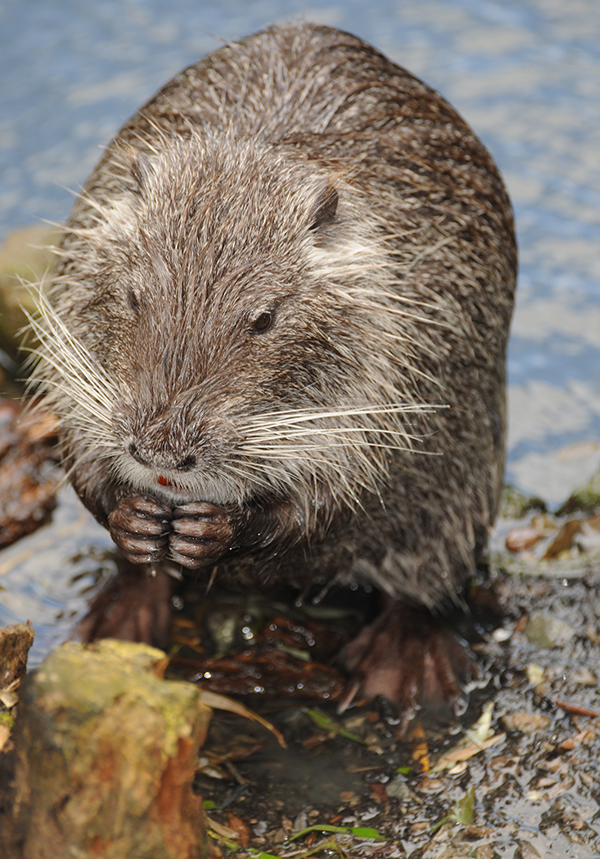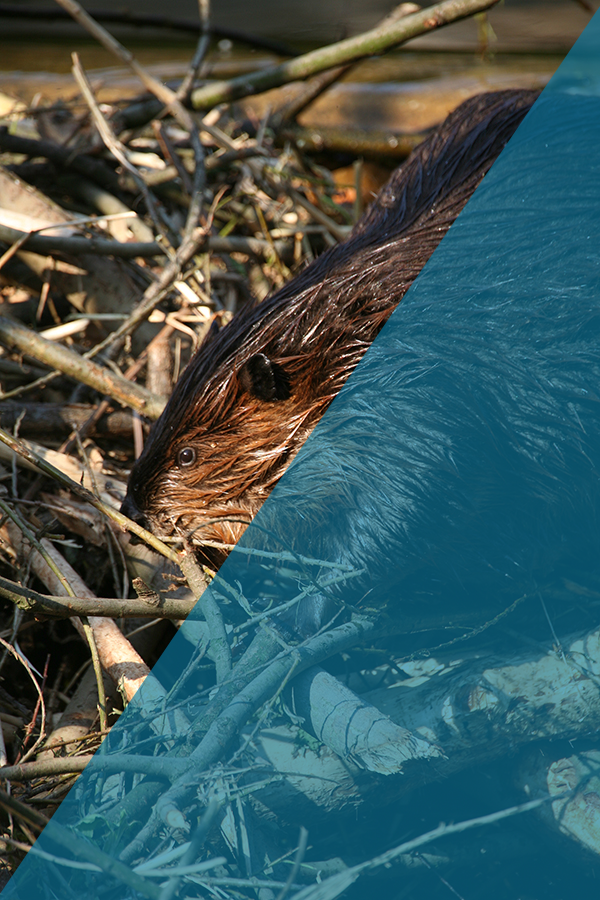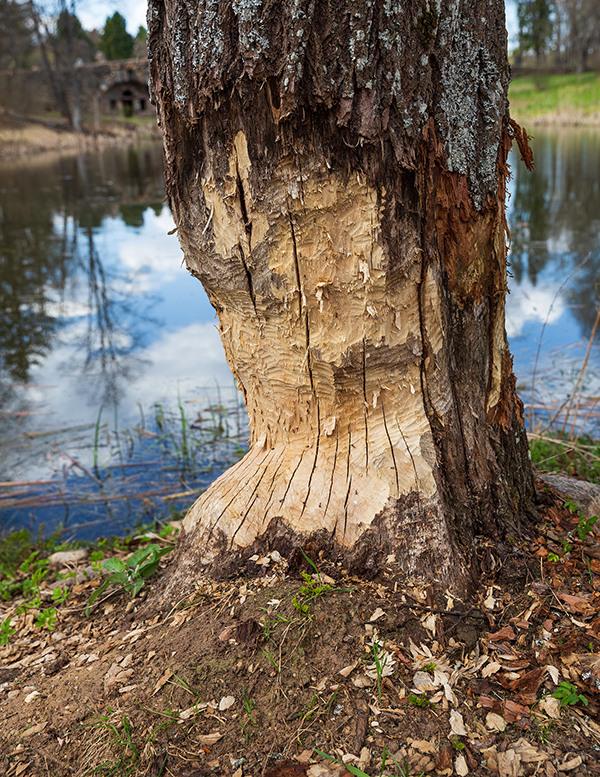
Sudden ponding where there wasn’t any before,
valuable trees gnawed down to pencil points, or
water unexpectedly creeping toward driveways or
even building foundations—beaver activity can
dramatically reshape a property much faster than
most people anticipate. Trapper Joe’s Wildlife
Control, LLC specializes in providing humane,
regulation-compliant beaver removal and control
services for residences, agricultural lands, and
commercial properties throughout the Greater
Indianapolis area. By combining calm, professional
beaver management strategies with state-approved
trapping methods when necessary and
appropriate, we ensure your property remains
intact, and water levels are restored to their proper
place.
Our team of licensed and insured beaver trappers utilizes humane methods that strictly adhere to both
Indiana and EPA regulations, consciously avoiding the use of harmful poisons and dangerous explosives. In
addition to our expert beaver trapping services, we offer valuable advice and referrals for effective flow-
control devices, such as specialized pond levelers, durable culvert guards, and protective fence exclosures,
all designed to prevent future beaver damage.
Have beavers managed to severely impact your property's banks or land? No problem—we also provide
insurance-compatible work and comprehensive documentation to assist with animal damage claims. Onsite
assessments are readily available for a small fee, which can then be credited back toward any service you
choose to proceed with. The overall cost of our wildlife control services depends on various factors, including
site access, water depth, the type and length of any necessary control devices, the pressure exerted by the
beaver colony, and similar factors. We are also able to phase our work: prioritizing urgent beaver extraction
first, followed by the implementation of long-term beaver controls and essential shoreline improvement
advice to safeguard your property.
If you’re ready to protect your Indianapolis property and address your beaver-related concerns, we’re here to
help every step of the way. Contact Trapper Joe's Wildlife Control, LLC today for a consultation and tailored
solutions to suit your specific needs. We proudly serve Greater Indianapolis areas, including Shelbyville,
Brownsburg, Carmel, Fishers, Ingalls, Bargersville, Greenwood, Lawrence, Lebanon, McCordsville,
Mooresville, Plainfield, Westfield, and more. We also partner with HOAs, parks, golf courses, and
municipalities across Central Indiana.
Don’t wait until the issue escalates—act now to safeguard your land and water features from costly damage.
Reach out via phone or email us to start discussing your wildlife pest control
options and take the first step toward effective and lasting beaver management solutions in Central Indiana

Catching beaver activity in its early stages can save you significant trouble and expense down the line,
preventing extensive damage to your property and the surrounding environment. Early detection allows for
timely intervention, mitigating potential structural issues, erosion, and tree loss. Keep a vigilant eye out for
these distinctive indicators that suggest the presence of beavers in your area:
Chewed Or Gnawed Tree Trunks and Branches Near Water Sources → Beavers are famous for their strong
teeth and their habit of felling trees. Noticeable tooth marks or freshly cut stumps, especially close to rivers,
ponds, or lakes, are clear signs.
Damaged Vegetation or the Sudden Disappearance of Smaller Trees → Beyond just larger trees, beavers
also feed on and use smaller plants and shrubs for their constructions. If you see young saplings gone
missing or strips of bark removed from plants, beavers might be the culprits.
Muddy Paths or Slides Leading into the Water → Beavers create well-worn paths, often appearing as
muddy slides, where they drag materials into the water or enter and exit their habitat. These are typically
found on the banks of waterways.
Blocked Culverts, Drainage Systems, or Irrigation Canals → Beavers are industrious builders and will
often block man-made water flow structures to create or expand their ponds. This can lead to unexpected
flooding or water diversion on your property.
Presence of Lodges or Dams Built From Sticks, Mud, And Debris → The most obvious sign of beaver
presence is their impressive engineering. Look for their characteristic dome-shaped lodges or the dams they
construct, which are typically made from a mix of branches, mud, and rocks, designed to create a deeper and
more stable water environment.
Unusual Water Level Changes in Ponds, Streams, Or Other Water Bodies → If you notice that water levels
in natural or artificial bodies of water on your property are rising or falling inexplicably, it could be due to
beaver dam construction impacting the natural flow.

We survey dam height, ponded area, culvert diameters, bank conditions, active slides, and chew pressure. You receive a photo-rich findings report, risk summary (what floods if the next storm hits), and an itemized plan.
Where rising water levels pose an immediate threat
to essential structures or access routes, we offer
trusted referrals for temporary relief measures. This
can include carefully managed partial notching of
dams under controlled conditions, strategic
placement of sandbags or construction of berms,
and the installation of debris screens.
Our approach always prioritizes safety and carefully considers potential downstream impacts, ensuring that
immediate solutions don't create new problems.
If removal is necessary, we use state-approved trapping methods and schedules that reduce stress and avoid non-target species. All handling complies with Indiana law and site constraints. (No poisons, no explosives.)
Long-term success depends on water behavior. We design and install culvert guards and exclosures that keep beavers from packing the inlet. We also install pond-leveler systems (intake pipes with protective cages) that pass flow quietly below the beaver’s trigger point (sound and velocity) and fence “beaver deceivers” that change hydraulics and make damming inefficient.
After live activity is addressed and flow devices are installed, we step-down dams strategically to the designed water level, controlling sediment release and preventing sudden downstream surges.
We are happy to provide referrals for wrapping high-value trees with hardware cloth (typically 3–4' high, spaced off bark), apply deterrent coatings where appropriate, and recommend plantings less attractive to beavers along the first few feet of shoreline.
We provide before/after photos, device locations, maintenance tips (e.g., periodic debris clearing at intake
cages), and even a warranty on certain work outlined in your estimate. Seasonal checkups are available for
high-pressure sites.
By choosing our services, you are making a conscious decision to invest in effective,
sustainable solutions specifically tailored to protect your property from beaver activity, all while preserving
the delicate balance of the surrounding ecosystem. Our dedicated team is deeply committed to delivering
high-quality, long-lasting animal trapping and removal results, all while providing
comprehensive support to you every step of the way, from initial consultation through implementation and
beyond.
Guard culverts: Install a sturdy fence exclosure around the culvert to prevent beavers from blocking it with branches and debris. Regularly check and clear the inlet of brush or obstructions to ensure water flows freely.
Wrap the trunks of vulnerable trees with wire mesh or hardware cloth to prevent beavers from chewing them down. Alternatively, plant less-palatable tree species, such as conifers or certain hardwoods, near water sources to deter beaver activity.
Beavers are naturally drawn to the sound of running or splashing water, which triggers their instinct to build dams. Installing a properly set water leveler can help direct water flow below these acoustic triggers, reducing the likelihood of damming activity.
After construction or maintenance projects near water, remove any leftover brush piles or stacked sticks from the banks. These materials are perfect building blocks for eager beavers looking to create dams or lodges.
Pay close attention to low spots or shoulders along embankments where water could overtop and carve out a new channel. Adjust or correct these areas to maintain proper drainage and prevent further issues.
We’ll tailor these to your site so maintenance is focused and affordable. Contact us today for a thorough consultation to discuss your specific needs and take the crucial first step toward safeguarding your land and waterways with the utmost confidence and ecological responsibility!
Our wildlife control specialists encounter beavers in a diverse range of locations across various landscapes. A consistent factor, however, is their proximity to a water source. Beyond this fundamental requirement, we frequently observe beavers inhabiting areas where human activities inadvertently offer them additional resources or advantageous opportunities for dam construction. Beavers are highly adaptable creatures, capable of thriving in various environments, from untouched wilderness to more developed areas. Consequently, our wildlife control specialists commonly find these industrious rodents in the following types of areas:
Beavers frequently target culverts, which are essentially large pipes or covered channels that allow water to flow under roads or driveways. They find these structures ideal for dam construction at their inlets, which can lead to significant water pooling and, in many cases, overtopping of the roadbed itself. This accumulation of water not only creates hazards for drivers but can also result in substantial, costly damage to the underlying road infrastructure if their activities are not addressed promptly.
These man-made ponds, commonly found within residential communities, commercial zones, and industrial parks, are designed to manage stormwater runoff. Beavers are highly attracted to these ponds due to their consistent water levels and often sheltered environments. They will typically construct their lodges along the rip-rap edges (rocky slopes designed to prevent erosion) or within secluded coves, where they feel secure. Their presence can lead to altered water flow, potential flooding of adjacent areas, and erosion problems along the pond's banks.

Beavers are adept at identifying natural pinch points within creeks and drainage ditches, areas where the water channel narrows or where flow naturally slows. These locations are particularly appealing as they make it easier for beavers to construct their characteristic woven stick dams, effectively creating barriers that significantly disrupt the natural flow of water, leading to upstream ponding and altered downstream conditions.
These meticulously maintained landscapes offer a wealth of attractive features for beavers. They are often drawn to the existing fairway drainage lines, the numerous culverts running beneath golf cart paths, and the well-defined edges of decorative ponds. Their dam-building and foraging activities can lead to localized flooding on fairways, damage to manicured recreational areas, and even undermine pathways and structures.
In agricultural landscapes, beavers can pose a significant challenge to drainage systems. They frequently block the outlets of buried drainage tiles, which are crucial for keeping fields dry and productive. This blockage causes water to back up into the fields, potentially waterlogging crops and hindering agricultural operations. Furthermore, beavers may cut into the banks of ditches or streams to access and disrupt these field tiles, further complicating farmland drainage.
Beavers are often found along the shorelines of private lakes, where they are drawn to the abundance of
ornamental plants, shrubs, and young trees. Their foraging behavior is characterized by distinctive chew
marks around the base of trees and woody plants, which can quickly lead to the loss of valuable landscaping.
Beyond plant damage, their activities can also contribute to erosion along the shoreline and alter the
aesthetic appeal of these private water bodies.
Understanding common beaver habitats and behaviors is the first step toward effective and responsible
wildlife management. Recognizing where and how beavers actually impact human interests allows for
targeted strategies that mitigate damage and promote coexistence with these industrious creatures. For
property owners facing beaver-related challenges, gaining deeper insights into their habits is crucial. Want to
learn more about managing beaver activity on your land or need expert advice on non-lethal deterrents and
removal options? Contact us today for a scheduled onsite consultation tailored to your specific
needs and ensure a balanced approach to beaver coexistence!
Simply removing a beaver dam is rarely a permanent solution. Beavers are highly motivated to rebuild, especially if the conditions that attracted them (like specific culvert geometry or the sound of flowing water) still exist. They can often reconstruct a dam overnight. Our approach combines dam removal with the installation of specialized flow devices that make rebuilding efforts unrewarding for the beavers, encouraging them to move on or adapt in a way that minimizes impact.
Our practices adhere strictly to Indiana regulations regarding the handling and disposition of wildlife. Beaver relocation options are generally limited and highly site-specific, often requiring permits and suitable receiving habitats. We will clearly explain the legally compliant paths available for your particular situation, which may include non-lethal deterrents or, in certain circumstances, state-approved trapping if other methods are not viable.
Absolutely not. Flow devices or "pond levelers" are specifically designed to maintain a desired water level. They are installed at a target elevation and only allow excess water to pass through, preventing flooding while preserving the water level you've chosen, within the natural limits of your landscape. This ensures your pond or water feature remains intact and healthy.
We prioritize aesthetics while providing robust protection. Our method involves using durable, low-profile hardware-cloth wraps around the base of trees. These wraps are typically spaced slightly off the bark to allow for tree growth and are often painted or coated to blend seamlessly with the environment. Additionally, we can offer advice on planting native species that beavers find less appealing, further deterring them from vulnerable areas.
Trapping is not always the first or only solution. In many situations, especially for new beaver activity, exclosures, tree protection, and flow devices can effectively manage the problem without the need for trapping. However, where beaver colonies are well-established, causing significant infrastructure damage, or posing safety risks, state-approved trapping might be a necessary component of a comprehensive management plan. We always assess the situation to recommend the most humane and effective strategy.
When implementing beaver management solutions, we always consider the broader hydrological context, including potential impacts on downstream properties. Our strategies, such as controlled dam modifications and the installation of stable flow devices, are designed not only to protect your property but also to prevent adverse effects on downstream neighbors by managing water flow responsibly and predictably.
Yes, we have extensive experience working with Homeowners Associations (HOAs), municipalities, and public land managers. We are adept at coordinating complex schedules, managing access to communal areas, and facilitating clear communication between boards, residents, and maintenance crews. We can also provide ongoing seasonal monitoring and maintenance plans to ensure long-term effectiveness of our solutions.
provide ongoing seasonal monitoring and maintenance plans to ensure long-term effectiveness of our solutions. How long does it take to see results? The timeline for results can vary depending on the specific beaver activity and the chosen management strategy. Non-lethal deterrents and flow devices often show effects relatively quickly, sometimes within days or weeks, as beavers react to the changes. For more entrenched issues involving dam removal and comprehensive mitigation, it may take a few weeks for beavers to fully adapt or relocate. We provide clear expectations during our consultation and monitor progress to ensure effectiveness.
Greenfield, Indiana
Indianapolis, Indiana
View Our Library of Wildlife Blogs
December 17, 2025
The sound is unmistakable—a frantic scratching or scurrying noise coming from directly above your head. For many homeowners, this unsettling soundtrack is the first sign that their roof has become a cozy nursery for a
December 4, 2025
Central Indiana is known for its beautiful seasons and diverse ecosystems. From the rolling hills of Brown County to the bustling neighborhoods of Indianapolis, our region is teeming with life. While spotting a cardinal
November 18, 2025
Hearing strange noises from your attic at night can be unsettling. For many homeowners in Indiana, the culprit is often a surprisingly common visitor: the raccoon. These clever, masked animals are drawn to the shelter a
Fill Out & Submit Our Email Form!